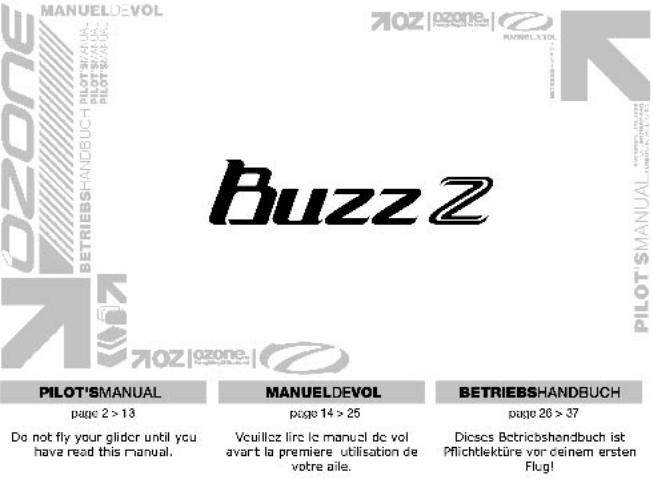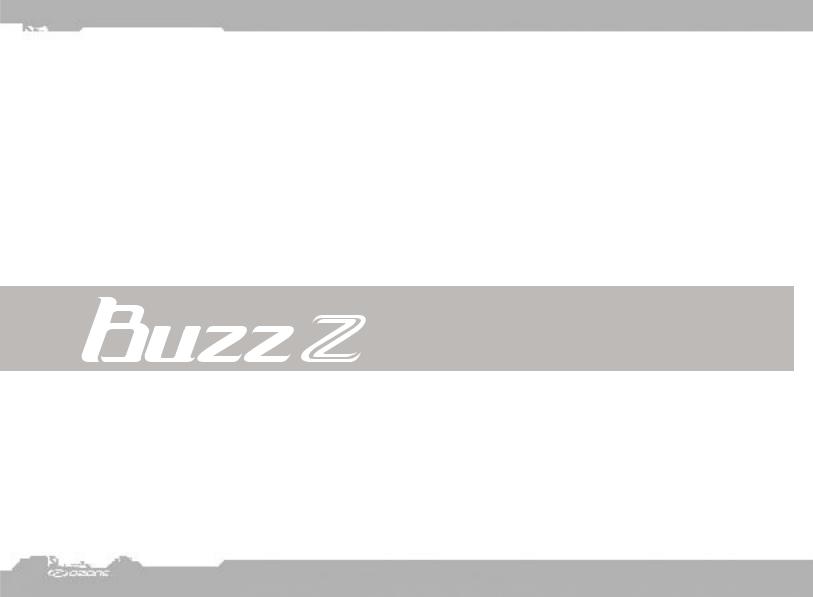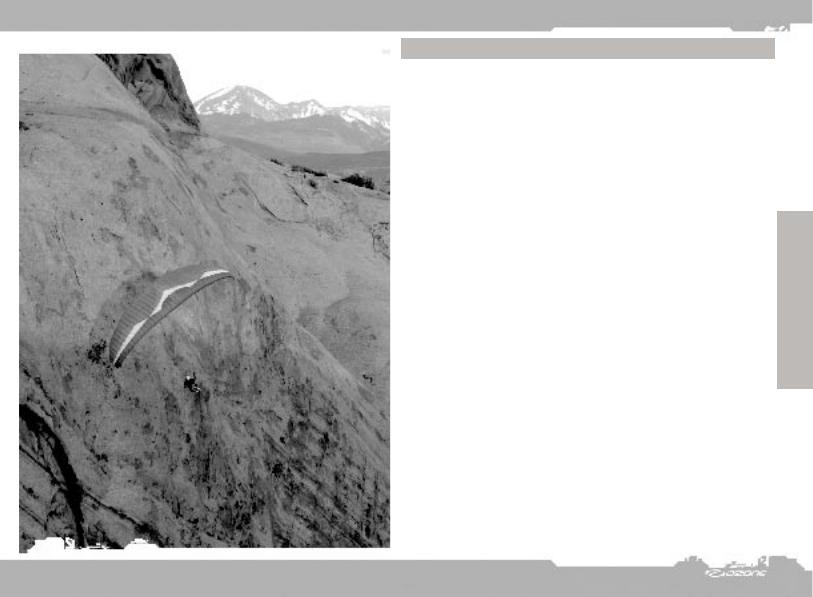
buzzZ
.pdf


PILOT’SMANUAL
page2>13
Line diagram>page38 - Riser diagram>page40 Technical specifications>page40
2

THANK YOU
Thank you for choosing to fly Ozone.
As a team of free flying enthusiasts, competitors and adventurers, Ozone’s mission is to build sweet handling, agile paragliders that produces ‘cutting edge’ performance, whilst still keeping you safe in rough air.
All our research and development is concentrated on creating the best handling characteristics possible with optimum security. Confidence and belief in your paraglider is a far greater asset than any small gains in performance - ask any of the Ozone pilots on your local hills, or those who have taken our gliders on groundbreaking adventures and stood on podiums around the world.
Our development team is based in the south of France. This area, which includes the sites of Gourdon, Monaco and Lachens, guarantees us more than 300 flyable days per year. This is a great asset in the development of the Ozone range.
As pilots we fully understand just how big an investment a new paraglider is. We know that quality and value for money are essential considerations when choosing your new paraglider; so to keep costs low and quality high we now build all our wings in our own production plant. This way we can guarantee that all our paragliders meet the same high standards that we expect ourselves.
This manual will help you get the most out of your Buzz Z. It details information about the Buzz Z’s design, tips and advice on how best to use it and how to care for it to ensure it has a long life and retains a high resale value. Along with this manual you will also have received a service card giving the technical specifications of your glider, line layout diagram, line length check table and a service record sheet. Please make sure this is completed and keep the card with the glider in case you need to replace a line.
If you need any further information about Ozone, the Buzz Z, or any of our products please check www.flyozone.com or contact your local dealer, school or any of us here at Ozone.
It is essential that you read this manual before flying your Buzz Z for the first time.
Please ensure that this manual is passed on to the new owner if you ever resell this paraglider.
Ozone’s web site, www.flyozone.com carries up-to-date information, including any safety issues or issues specific to your Buzz Z. Please check it regularly.
Safe Flying!
All the team @ Ozone
ENGLISH
3

WARNING |
TEAM OZONE |
Paragliding is a potentially dangerous sport that can cause serious injury including bodily harm, paralysis and death. Flying an Ozone paraglider is undertaken with the full knowledge that paragliding involves risks.
As the owner of an Ozone paraglider you take exclusive responsibility for all risks associated with its use. Inappropriate use and or abuse of your equipment will increase these risks.
Make sure you seek professional tuition and learn with a reputable school. Ozone paragliders are only suitable for qualified pilots or those under instruction.
Any liability claims resulting from use of this product towards the manufacturer, distributor or dealers is excluded.
Be prepared to practice as much as you can - especially ground handling, as this is a critical aspect of paragliding. Poor control while on the ground is one of the most common causes of accidents.
Be ready to continue your learning by attending advanced courses to follow the evolution of our sport, as techniques and materials keep improving.
Use only certified paragliders, harnesses with protector and reserve parachutes that are free from modification, and use them only within their certified weight ranges. Please remember that flying a glider outside its certified configuration may jeopardise any insurance (e.g. liability, life etc) you have. It is your responsibility as the pilot to verify your insurance cover.
Make sure you complete a thorough daily and pre-flight inspection of all of your equipment. Never attempt flying with unsuitable or damaged equipment.
Always wear a helmet, gloves and boots.
All pilots should have the appropriate level of license for their respective country and third party insurance.
Make sure that you are physically and mentally healthy before flying. Choose the correct wing, harness and conditions for your level of experience.
Pay special attention to the terrain you will be flying and the weather conditions before you launch. If you are unsure do not fly, and always add a large safety margin to all your decisions.
Avoid flying your glider in rain, snow, strong wind, and turbulent weather conditions or clouds.
If you use good, safe judgment you will enjoy many years of paragliding. Remember, PLEASURE is the reason for our sport
Everyone at Ozone continues to be driven by our passion for flying, our love of adventure and our quest to see Ozone's paraglider development create better, safer and more versatile paragliders.
Paragliding design is led by the ever thoughtful David Dagault; Dav has a wealth of experience both in competition, adventure flying and paraglider design. Also on the design team are test pilots Jerome Canaud and Russell Ogden. Jerome is a true acro spirit who has instructed paragliding for many years. Russell is a top competition pilot and paragliding instructor - they can usually be found putting Dav's latest creation through a series of tests and acro manoeuvres.
Back in the office Mike 'Da Boss' Cavanagh generally keeps control of the mayhem. Promotion and Team pilots are organised by Matt Gerdes, our resident base jumping expert. Manu Prissette looks after all our adverts, videos and communication, as well as trying to keep the computers running. Karine Marconi makes sure we don't spend too much money whilst if you phone us you are likely to hear the dulcet tones of Nicky Watts.
Our manufacturing facility in Vietnam is headed up by Dr Dave Pilkington, who works relentlessly manufacturing gliders and producing prototypes as well as researching materials and manufacturing processes for our future products. He is backed up by Ngan and 400 production staff.
YOUR BUZZ Z
Following on from the successful Buzz, the Buzz Z has been updated and redesigned to improve performance and ease of use. The Buzz Z is a solid mid-range DHV 1-2 glider for pilots who want a wing that has a combination of sporty handling, great speed and maximum safety. It is suitable for low airtime pilots who are learning and discovering their new sport and more experienced pilots who prefer maximum safety and maximum fun.
There have been many changes incorporated in the new design: The profile has been developed from the new Mojo 2; cell openings have been reduced in size and their position optimised; new plan form with an increased number of cells and proportional reduction toward the tips; new line plan which reduces total consumption by 47m. This innovation improves the Buzz Z’s characteristics at high and low angles of attack, making launching easier, slow speed and high speed flight more forgiving as well as improving overall sink rate, glide and speed performance.
On the ground the Buzz Z is well balanced with little tendency to overshoot or sit back making alpine and reverse launches simple. Inflation is smooth and progressive with a positive pressure through the risers; making it easy to feel exactly where the glider is, giving easy, stress-free launches.
4

In the air the Buzz Z is a joy to fly, brake pressure is perfect, building continuously as more brake is applied and becoming progressively harder as the stall / spin point is reached. The Buzz Z offers just the right amount of feedback through the risers and brakes, helping you feel the thermals and rough air without overloading your senses with too much unnecessary information.
The wing is well damped in pitch, this helps it cut through turbulence efficiently, making it very resistant to deflations and improving its re-inflation characteristics.
The Buzz Z has a large useable speed range to help you out on sinky glides or when you need to push into a headwind. At full speed the leading edge remains solid, even in turbulence. The Buzz Z’s direct handling, easy-turn, sink rate and glide performance make it an ideal thermalling and XC machine.
The Buzz Z is the perfect choice for new pilots or for those seeking unparalleled security and performance. It will take you as far as you want to go whilst inspiring you with confidence and putting a smile on your face.
Bag
The bag has been designed to be comfortable and useful (padded hip belt, ergonomic and adjustable shoulder straps). It has a large volume that will allow you to store all your kit, whilst still being comfortable for hiking. We've also added some pockets on the side and on the top, handy for all those easily lost accessories.
Brake Lines
The brake line lengths have been set carefully during testing. We feel it is better to have slightly long brake lines and to fly with a wrap (one turn of line around the hand). However, if you do choose to adjust them, please bear in mind the following:
•Ensure both main brake lines are of equal length.
•If a brake handle has been removed, check that its line is still routed through the pulley when it is replaced.
•When the brake handles are released in flight, the brake lines should be slack. There must be a substantial "bow" in them to guarantee no deformation of the trailing edge.
•There must be a minimum of 10cm of free play before the brakes begin to deform the trailing edge. This prevents the trailing edge from being deformed when using the speed system.
the back, holding only one line, is the "Baby A"; it has been designed to make applying "Big Ears" simple.
The B's are BLUE The C's are BLACK
Accelerator System
To set up an accelerator on the ground, ask a friend to pull your risers into their inflight position while you sit in your harness. Now adjust the length of the line so that the main bar sits just beneath your seat. You should now be able to hook your heel in to the secondary (lower) loop of the accelerator.
The accelerator must be slack enough to ensure that the front risers are not pulled down in normal flight, but not so long that it is impossible to use the full speed range of the Buzz Z.
Extending the secondary (lower) loop of the accelerator fully will take the Buzz Z |
|
|
through approximately half its accelerated speed range. Should you need even more |
|
|
speed you should hook your feet on to the upper bar, which you can then extend until |
|
|
the pulleys on the risers touch. |
|
|
Once set up, test the full range of the accelerator in calm flying conditions: ensure that |
|
|
both risers are pulled evenly during operation. Fine-tuning can be completed when you |
ENGLISH |
|
are back on the ground. |
||
|
||
IMPORTANT : Using the accelerator decreases the angle of attack and can |
|
|
make the glider more prone to collapse, therefore using the accelerator near |
|
|
the ground or in turbulence should be avoided. |
|
|
Harness |
|
|
It will be in your harness that you will enjoy flying... Therefore, we recommend you |
|
|
spend the time necessary to adjust your harness's different settings, which will make |
|
|
flying more pleasurable, because you are comfortable. |
|
|
The shoulder straps and the hip straps need to be set (make sure you do not have your |
|
|
shoulder's strap too tight, or you might find it difficult to get seated after launching). |
|
|
Your ideal position in your harness should be comfortable, leaning slightly backwards |
|
|
with your head behind the risers.. |
|
|
The chest strap should be set at 42, 44, 46cm (between the centres of the risers) for |
|
|
sizes S, M, L respectively. |
|
IMPORTANT : In the unlikely event of a brake line snapping in flight, or a handle becoming detached, the glider can be flown by gently pulling the rear risers (C-risers) for directional control.
Risers
The Buzz Z has been designed with 3 risers. Each riser is covered with coloured webbing, this allows them to be easily identified.
The A's are RED. You will notice that the A's are split in two parts. The small riser on
Total weight in flight
Each Buzz Z has been certified for a defined weight range. We recommend that you respect these weight ranges. If you are between sizes the following information may help you make a decision as to which size to buy:
If you want better speed, precise handling, if you generally fly in mountains and/or in strong conditions, you should chose to fly in the top part of the weight range.
If you want a better sink rate, if you generally fly in flat lands and/or in weak conditions,
5

you may choose to fly in the bottom part of the weight range. Remember, you can always add ballast for when conditions are stronger.
BASIC FLIGHT TECHNIQUES
To familiarise yourself with the glider it is a good idea to perform practice inflations and small flights on a training hill. This will enable you to set up your equipment correctly. If in any doubt please get advice and help from your local dealer or instructor.
Preparation
Lay out the Buzz Z on its top surface in a pronounced arc, with the centre of the wing higher than the tips. Lay out the lines one side at a time. Hold up the risers and starting with the brake lines, pull all lines clear. Repeat with the C, B and A lines, laying the checked lines on top of the previous set, and making sure no lines are tangled, knotted or snagged. Mirror the process on the other side.
Take-off checklist:
1.Check reserve parachute - pin in and handle secure
2.Helmet on and fastened
3.All harness buckles closed - check leg-loops again
4.Karabiners and maillons tight
5.Holding the A's and your brake handles
6.Leading edge open
7.Aligned directly into wind
8.Airspace and visibility clear
Launching
Your Buzz Z will launch with either the forward or reverse techniques.
Whilst inflating your wing, you should hold both of the A risers (main A and baby A) on each side. Once clipped in, and you have gone through the take-off check list (above), stand central to the wing to ensure an even and progressive inflation.
Forward Launch - Nil to Light winds
When the wind is favourable, move forward positively: your lines should become tight within one or two steps. The Buzz Z will immediately start to inflate. You should maintain a constant pressure on the risers until the wing is overhead.
Do not pull down or push the risers forward excessively, or the leading edge will deform and possibly collapse making taking-off more difficult and potentially dangerous.
Move smoothly throughout the entire launch, there is no need to rush or snatch at it. You should have plenty of time to look up and check your canopy before committing yourself.
Once you are happy that the Buzz Z is inflated correctly, accelerate smoothly off the launch.
Reverse Launch -Light to Strong Winds
Lay out your Buzz Z as you would for the forward launch. However, this time turn to face the wing, passing one entire set of risers over your head as you turn. Now you can pull the Buzz Z by its A-risers. Once the wing is overhead, brake it gently, turn and launch.
In stronger winds, be prepared to take a few steps towards the glider as it inflates. This will take some of the energy out of the glider and it will be less likely to overfly you. This reverse-launch technique can be used in surprisingly light winds too.
IMPORTANT : Never take off with a glider that is not fully inflated or if you are not in control of the pitch/roll of your wing.
Practice ground handling a lot! It's great fun, and will give you a much better feel for your Buzz Z’s flight characteristics. It will also improve your overall enjoyment of flying by making your launches easier.
In Flight Characteristics
The Buzz Z shows no unusual flying characteristics, consequently it is suitable for a very wide range of pilot. In turns, the Buzz Z is smooth and co-ordinated, on glides it remains solid and well pressured, even through the accelerated speed range. It has a very high resistance to both collapses and stalls. However, to get the most out of your Buzz Z we advise you to consider the following information:
Normal Flight
Flying at 'trim speed' (hands-up), the Buzz Z will achieve its 'best
glide' speed for normal air. You should fly at this speed when gliding downwind or when the air is not excessively sinking.
For better penetration in headwinds and improved glide performance in sinking air, crosswinds or headwinds, you should fly faster than trim speed by using the
accelerator system. Using up to half bar does not degrade the glide angle or stability significantly and will improve your flying performance, as you will reach the next thermal faster and higher. At full speed the Buzz Z is stable; however we recommend that you do not fly at full speed close to the ground or in turbulence.
By applying the brakes approximately 30cm, the Buzz Z will achieve its minimum-sink rate; this is the speed for best climb and is the speed to use for thermalling and ridge soaring.
Turning
To familiarize yourself with the Buzz Z your first turns should be gradual and progressive.
To make efficient and coordinated turns with the Buzz Z first look in the direction you want to go, then lean into it. Your first input for directional change should be weightshift, followed by the smooth application of the brake until the desired bank angle is
6

achieved. To regulate the speed and radius of the turn, coordinate your weight shift and use the outer brake.
IMPORTANT: Never initiate a turn at minimum speed (i.e. with full brakes on) as you could risk entering a spin.
Active Flying
To minimize the likelihood of suffering collapses in turbulent conditions, it is essential to use active flying.
All good pilots react to the feedback the gliders send them, and are constantly adjusting their speed and pitch to match the movements of the air. The key elements of active flying are pitch control and pressure control:
As the glider pitches in front of you, use the brakes to slow it down. Equally, as the glider drops behind you, release the brakes to allow it to speed up.
Flying with a bit of brake applied (approx. 20cm) will give you feedback from the wing. In turbulent conditions the internal pressure of the wing can change and you can feel this through the brakes. The aim is to maintain a constant pressure through the brakes. If you feel a loss in pressure apply the brakes until normal pressure is resumed then raise hands back to original position (this must be done quickly).
Avoid flying with continuous amounts of deep brake in rough air as you could inadvertently stall the wing. Always consider your airspeed.
These movements can be symmetric or asymmetric; you may have to apply both brakes or just one. These subtle adjustments will keep the glider flying smoothly and directly above you and dramatically reduce the chances of a collapse. These are skills that are best learnt by playing with the glider on the ground!
IMPORTANT: No pilot and no glider are immune to collapses however active flying will virtually eliminate any tendency to collapse. When the conditions are turbulent, be more active and anticipate the movements of your wing. Always be aware of your altitude and do not over-react. We advice you to keep hold of your brakes. Do not fly in turbulent conditions.
Landing
The Buzz Z shows no unusual landing characteristics but as a reminder, here are some tips:
•Always set up your landing early, give yourself plenty of options and a safe margin for error.
•Once below 30 metres avoid turning tightly as the glider will have to dive to accelerate back to normal flight. If you are at low altitude, or if you hit sink, this could mean you hit the ground harder than necessary.
•Instead, allow the glider to fly at full speed for your final descent until you are around
1 metre above the ground. Apply the brakes slowly and progressively to slow the glider down until the glider stalls and you are able to step onto the ground.
•Be careful not to flare too hard at full speed as the glider might climb again before stalling. If the glider does begin to climb, ease off the brakes until it stops climbing - but don't put your hands right up - then flare again, but more gently this time. Keep the brakes at mid speed, stand up, be ready to run and make sure you brake fully as you arrive on the ground.
•Lean forward out of your harness before the actual landing (especially if it's turbulent), with your weight leaning forward against the chest strap, and make sure your legs are ready for the landing and a possible PLF (parachute landing fall).
•Choose the appropriate approach style in function of the landing area and the conditions.
•Always land heading into wind!
•In light winds you need a strong, long and progressive flare to bleed off all your excess ground speed. In strong winds your forward speed is already low so you are flaring only to soften the landing. A strong flare may result in the glider climbing
upwards and backwards quickly, leaving you in a vunerable position.
•In strong winds you need to turn towards the glider the second your feet touch the ground. Once facing the wing pull smoothly and symmetrically down on the brakes to stall the wing. If the glider pulls you, run toward it.
•If the wind is very strong, and you feel you might be dragged, stall the glider with the C risers. This stalls the Buzz Z in a very quick and controllable way and will drag you less than if you use the brakes.
Packing
•Spread the glider flat on its top surface, then lay the lines on top. The risers should be laid on the ground, at the centre of the glider, near the trailing edge.
•Take a wing tip and fold it in to the centre of the wing. Repeat this until the glider is folded up and approx. 60 cm's wide.
•Do the same to the other side of the glider. Always make sure that the leading edge is kept in one straight line, as it is important not to badly crease the reinforcing fabrics in the leading edge.
•Don't fold the glider along the same lines every time; any type of folding reduces the strength of the fabric over time.
•Push out any remaining air by flattening the folded wing from the trailing edge to the leading edge.
•Fold the glider so that the bundle is approximately the size and shape of the Ozone rucksack. Never roll the wing up as this introduces unnecessary stresses into the fabric.
•Always pack your Buzz Z as loosely as you can, as every fold weakens the cloth on any paraglider.
•Finally, wrap the glider tie around the bundle and put it in the stuff sack.
•Packing your glider using the concertina method, keeping the mylar reinforcements flat may prolong the life your glider.
ENGLISH
7

ADVANCED FLIGHT TECHNIQUES
Rapid Descent Techniques
Ozone would like to remind you that these manoeuvres should be learnt under the supervision of a qualified instructor and always used with caution. Never forget that properly analysing the conditions before launch will help avoid the need to use these techniques.
Big Ears
Folding in the wingtips of the Buzz Z increases its sink rate. This is useful for staying out of cloud or descending quickly. To pull big ears on the Buzz Z, keep holding your brake handles and take the outermost A-line (Baby A) on each side, then pull it down until the tips of the wing fold under.
Do not use the brakes other than for re-inflation. For directional control while using the Big Ears, you should use weight shift steering.
To reopen your big ears, release both baby As at the same time. To help reinflation, brake gently one side at a time until tips regain pressure. Avoid deep symmetric applications of the brake as this could induce parachutal or full stalls.
IMPORTANT : You can land with the ears (you should release the ears before final flare). Ozone do not advise you to do this when it's turbulent or windy due to the risk of a possible stall and lack of precision in steering.
Big ears and accelerator
Once the big ears are in you can further increase the sink rate by pushing on the accelerator bar.
NEVER try to pull the Big Ears in with the speed bar on. This can lead to a major asymmetric deflation.
Big ears and spiral dive
Whilst it is possible to enter a spiral dive whilst holding in Big Ears, the high forces applied to the lower lines could exceed the breaking strain of the lines leading to equipment failure!
Ozone do not recommend the use of this manoeuvre!
Wingovers
The Ozone Buzz Z is not designed for aerobatic flying. The limit is tightly banked S- turns, commonly known as wingovers. These must not exceed 90 degrees of bank.
Warning : Uncoordinated wingovers can lead to large asymmetric collapses and therefore should never be executed near the ground.
B-Line Stall
B-stall is for fast descents in emergency situations only. B-stall is performed by symmetrically pulling down on the B-risers.
To initiate the B-stall place your fingers between the lines above the maillons on the B risers. Do not release the brake handles. As you pull the B-lines down the airflow over the wing is broken and the glider loses its forward speed but remains open and you will descend at around 6 m/s.
If you pull too much B-line the glider will horseshoe and move around a lot.
To exit the B-stall the B-risers should be released symmetrically and in one smooth, progressive motion. The glider will resume normal forward flight without further input. Check you have forward flight again before using the brakes.
IMPORTANT : The pitching movement on exiting the B stall is small but necessary. We recommend you do not brake the glider until you are sure that the glider is flying again.
The load applied on the B lines during this manoeuvre is not very good for your glider, only use it in emergency situations.
Spiral Dives
If you turn your Buzz Z in a series of tightening 360's it will enter a spiral dive. This will result in rapid height loss. To initiate a spiral, look and lean in to the direction you want to go, then smoothly pull down on the inside brake. The Buzz Z will first turn almost 360 degrees before it drops into the spiral. Once in the spiral you must apply a little outside brake to keep the outer wing tip pressured and inflated.
Safe descent rates of 8m/s (500 ft/min approx.) are possible in a spiral dive, but at these rates the associated high speeds and G-forces can be disorientating, so pay particular attention to your altitude.
To exit the spiral dive, return your weight shift to a central position and then slowly release the inside brake. As the Buzz Z decelerates allow it to continue to turn until enough energy is lost for it to return to level flight without an excessive climb and surge. The Buzz Z shows no tendency to remain locked in a spiral dive; however some parameters could interfere with its behaviour. These might include: wrong settings of the chest strap (too wide); total weight in flight outside of the certified weight range, or being in a very deep spiral at a very high sink rate. You should always be prepared to pilot the wing out of such a spiral dive. To do so smoothly use opposite weight shift and apply a small amount of outside brake and the glider will start to resume normal flight. Never attempt to recover from a spiral with hard or quick opposite inputs as this will result in an aggressive climb and surge.
IMPORTANT : Spiral dives with sink rates over 8 m/s are possible, but should be avoided. They are dangerous and put unnecessary strain on the glider. Spiral dives cause disorientation and need time and height to recover. Do not perform this manoeuvre near the ground.
8
